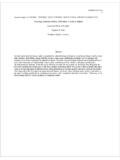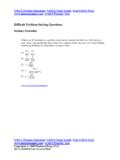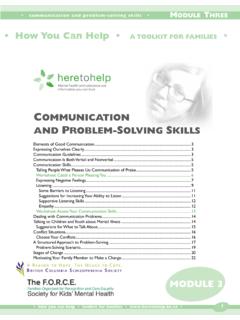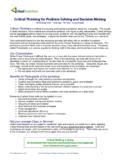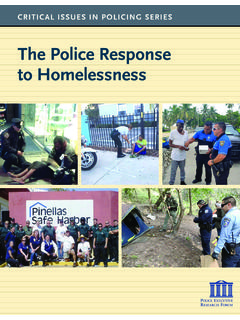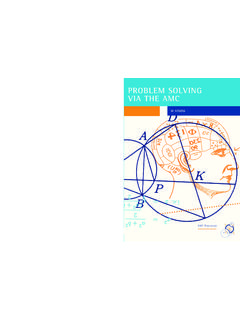Transcription of THE RELATIONSHIP BETWEEN WELL-STRUCTURED …
1 The Pennsylvania State UniversityThe Graduate SchoolCollege of EducationTHE RELATIONSHIP BETWEENWELL- structured AND ILL-STRUCTUREDPROBLEM solving IN MULTIMEDIA SIMULATIONA Thesis inInstructional SystemsbyNamsoo Shin HongSubmitted in Partial Fulfillmentof the Requirementsfor the Degree ofDoctor of PhilosophyAugust 1998iiiABSTRACTP roblem solving , especially complicated ill- structured problem solving , has been amajor concern in education. Research of the past decade provides qualitative ways ofviewing the solving processes of ill- structured problems. Sinnott, Voss & Post, andJonassen suggested that ill- structured problem solving has to support new, more qualitative,components than those for solving WELL-STRUCTURED study set forth to test the theory that the problem - solving skills used for WELL-STRUCTURED problems are necessary but not sufficient for solving ill- structured problems inthe context of an open-ended, multimedia problem - solving environment.
2 Two sets of open-ended questions were posed to reflect students solving skills in WELL-STRUCTURED and ill- structured problems involving astronomy , various instruments including domain-specific knowledge, structuralknowledge, and justification skills were developed to measure students necessary cognitivecomponents for solving problems. Finally, inventories such as science attitude, motivationin astronomy, knowledge of cognition, and regulation of cognition were employed to collectthe appropriate data of metacognition and non-cognitive , judgmental scoring systems were developed using a quantitative indexintended to reflect the extent to which subjects possessed solving skills as well as certaincognitive components of WELL-STRUCTURED and ill- structured problems. The results of thisstudy verified past research conclusions that WELL-STRUCTURED and ill- structured problemsrequire different necessary components for reaching successful overall, cognition, including domain-specific knowledge and structuralknowledge, and justification skills were critical components for successful solution in WELL-STRUCTURED problem solving .
3 Alternatively, metacognition, non-cognitive variables,justification skills, as well as cognition, were found to be essential components needed tosolve ill- structured problems. Implications for science education in a multimedia simulationenvironment, assessment on problem solving , and problem - solving research are OF CONTENTSLIST OF TABLESVIIILIST OF FIGURESXACKNOWLEDGMENTSXICHAPTER 1. INTRODUCTION1 Rationale for of the Study ..1 problem of RELATIONSHIP BETWEEN WELL-STRUCTURED and of Research Studies in Ill- structured of the of WELL-STRUCTURED problem of Ill- structured problem solving ..9 Research Questions ..9 CHAPTER 2. LITERATURE REVIEW11 WELL-STRUCTURED Problems ..11 solving Process of WELL-STRUCTURED of WELL-STRUCTURED problem - solving Processes ..13 Components for solving WELL-STRUCTURED of Process of Ill- structured Problems ..17 Representation Problems ..19 Solution and of Ill- structured problem - solving of solving Ill- structured Problems.
4 Of of of Components for solving Ill- structured Problems ..30 Differences BETWEEN WELL-STRUCTURED and Ill- structured Problems ..30 Research Summary ..35 CHAPTER 3. Design .. Variables of Science-Related of Motivation in Astronomy (TMA)..41 problem - solving Processes and Component Measures ..43 WELL-STRUCTURED problem - solving Processes Inventory (WPSPI) ..44 Ill- structured problem - solving Processes Inventory (IPSPI) ..45viCognition Inventory (CI) ..48 Justification Inventory (JI) ..48 Developing Scoring Validity of Scoring of the Tests .. 4. RESULTS58 Results of WELL-STRUCTURED problem solving ..58 Results of Near-Transfer Ill- structured problem solving ..61 Results of Far-Transfer Ill- structured problem solving ..63 Summary of Results ..65 CHAPTER 5. DISCUSSION66 WELL-STRUCTURED problem solving ..66 Ill- structured problem Implication on problem Implication on problem Implication on problem of Discussion.
5 80viiREFERENCES81 APPENDIX A. RESEARCH RECRUITMENT LETTER92A Recruitment Letter: B. QUESTIONNAIRES94 Student Do You Solve of Science-Related of Motivation in C. FACTOR LOADING102 Factor Loading of How Do You Solve D. problem - solving INSTRUMENTS105 problem - solving Exercise Part 1: WELL-STRUCTURED Problems ..106 problem - solving Exercise Part 2: Ill- structured Problems ..108 APPENDIX E. SCORING SYSTEMS113 WELL-STRUCTURED problem - solving Scoring Ill- structured problem - solving Scoring Ill- structured problem - solving Scoring System ..131viiiLIST OF TABLEST able Examples of Studies in Ill- structured problem solving ..5 Table Comparisons of problem solving , Science Processes and ScientificInquiry ..6 Table Ill- structured problem - solving Summary of Differences BETWEEN well - and Ill- structured Summary of Comparison Eigenvalues BETWEEN K1 Analysis and Parallel Analysisin HSP (n = 118).
6 40 Table Comparison Eigenvalues BETWEEN K1 Analysis and Parallel Analysisin TMA (n = 118) ..42 Table Example of WELL-STRUCTURED problem Testing Items ..45 Table Example of Near-Transfer Ill- structured problem Testing Items ..46 Table Example of Far-Transfer Ill- structured problem Testing Items ..47 Table Example of Domain-Specific Knowledge and Structural KnowledgeTesting Testing Items for Measuring Justification Skills in Testing Item for Measuring Justification Skills in Near-TransferIll- structured problem ..51 Table Testing Item for Measuring Justification Skills in Far-TransferIll- structured problem ..51 Table Comparison BETWEEN Novice and Expert Groups ..54 Table Inter-Rater Reliability BETWEEN Time Schedule for Instrument Intercorrelations among the Independent Variables in well -StructuredProblem Summary of Simultaneous Regression Analysis for Variables PredictingWell- structured problem - solving Scores (N = 118).
7 60ixTable Intercorrelations among the Independent Variables in Near-Transfer Ill- structured problem Analysis ..61 Table Summary of Simultaneous Regression Analysis for Variables PredictingNear-Transfer Ill- structured problem - solving Scores (N = 112) ..62 Table Intercorrelations among the Independent Variables in Far-Transfer Ill- structured problem Analysis ..63 Table Summary of Simultaneous Regression Analysis for Variables PredictingFar-Transfer Ill- structured problem - solving Scores (N = 111) ..64xLIST OF FIGURESF igure Diagram of WELL-STRUCTURED problem - solving Diagram of Ill- structured problem - solving Processes ..22 Figure Scree Test of the TMA Eigenvalues Plot ..42xiACKNOWLEDGMENTSThe research reported herein was supported by the Classroom of the Future(COTF), funded in part as a research and development center by the National Aeronauticsand Space Administration (NASA) as well as the West Virginia Space Grant Consortium,Wheeling Jesuit University.
8 The opinions expressed do not necessarily reflect the positionor policy of NASA COTF, and no official endorsement should be wish to acknowledge the support and assistance of the COTF research team. Theyencouraged the trial and pilot, and permitted me to learn from their experiences. I am alsograteful to Teresa Wiltse of the NorthWest High School for her help in the conduct of sincere thanks are extended to David Jonassen, my thesis advisor and mymentor, for his invaluable knowledge and inspiration to my professional growth. I alsowish to thank Hoi Suen for his assistance with the analysis despite his many thanks go particularly to Ashear Barr for reading drafts of much of my workand to her family for their warm and faithful 1. INTRODUCTIONR ationale for InvestigationProblem solving , especially complicated everyday problem solving , has been a majorconcern in education. One major goal for schools is to educate students who are able toexperience the richness and excitement of knowledge about the natural world, be aware ofdifficult real-world problems, and use appropriate processes and principles in makingpersonal decisions (National Science Educational Standard, 1996).
9 In other words, studentsmust learn ill- structured problem - solving skills by experiencing various real life situationsin order to make personal decisions. Many of the problems we face in real life are ill- structured , including important social, political, economic, and scientific problems in theworld (Sinnott, 1989; Voss, 1989, 1991).Educators agree on the importance of the role of ill- structured everyday problem - solving skills in school (Helgeson, 1992). They have attempted to put forth considerableeffort to enhance students problem solving using various teaching and learning strategies,and innovative instructional materials, such as multimedia , more alternative suggestions and promising directions for improving ill- structured problem solving are needed. Research efforts must include a furtherunderstanding of the nature of ill- structured problem solving as well as a reevaluation of themethods of instruction for creating rich learning environments to promote everyday ill- structured problem of the StudyThe purpose of this research study is to test the theory that the problem -solvingskills used for WELL-STRUCTURED problems are necessary but not sufficient for solving ill- structured problems (Brabeck & Wood, 1990; Kitchener & King, 1981; Mines et al.)
10 , 1990;Wood, 1990; Wood & Games, 1991) and that ill- structured problem solving has to supportmore qualitatively new components than those for solving WELL-STRUCTURED problems(Reitman, 1965). Ill- structured problems are commonly faced in everyday humanexperience; they have various solutions and has multiple solving processes which can bederived depending on a solver s , problem solving has been one of the dominant fields of research in thestudy of human information processing over the past three decades. Research has focusedon problems that are relatively well -defined or WELL-STRUCTURED (Reitman, 1965; Simon,1973). WELL-STRUCTURED problems are clearly presented with all the information needed athand and have convergent answers and single solving processes to reach a final solution(Simon, 1978), such as long division, areas of triangles, Ohm s law, and linear equations(Wilson & Cole, 1992). Consequently, theories of problem solving have been largelypervaded by the empirical phenomena of WELL-STRUCTURED problems.
